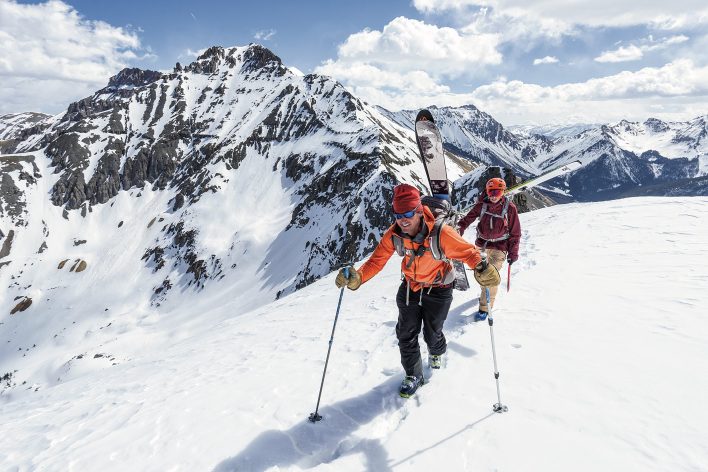
It hadn’t even snowed. Last winter, deep in a high-pressure cycle, I headed out to Snoqualmie Pass to get some exercise. The skintrack was packed, and my partner and I popped out in the Source Lake Basin to find several groups.
Crowding has reach a point where the Northwest Avalanche Center (NWAC) and search and rescue groups are worried and trying to figure out how to smartly address the issue. “There have been several close calls including multiple parties skiing on top of each other or descending complex terrain while other users are ascending,” said the NWAC in a joint statement with King County Search and Rescue.
Their solution is one that other organizations are rolling out in other heavily trafficked areas like Utah’s Wasatch Mountains: radio channels specifically set aside for backcountry communication. Here in Washington, the NWAC has set up dedicated channels and privacy codes for the Kendall, Hyak and Snow/Source Lake zones on Snoqualmie Pass. The Utah Avalanche Center set up a similar program, and they have an emergency channel, too. And the Teton Backcountry Alliance has been talking about initiating a program on and around Teton Pass, Wyoming.
The idea is that, on those channels, you’ll be able to communicate within your party and with groups above and below you to make sure you’re not dropping in on each other; to share conditions, plans, hazards and reports with other parties; and to have an additional way to reach authorities and help in an emergency. “It seems like the dam broke this season and now they’re getting established all over the place,” says Bruce Edgerly, who has researched the efficacy of radios and is vice president of Backcountry Access, which manufactures them.
The radio channel idea started in Telluride, Colorado, in 2014. Matt Steen—former San Juan forecaster for the Colorado Avalanche Information Center and Telluride Ski Resort patroller and current director of snow safety at Telluride Helitrax—says there was an increasing number of users in the high-use, easy-access terrain near the ski area, like Bear Creek and Gold Hill. “We were brainstorming how we could assist with better navigating and protecting yourself, and we thought, ‘Why don’t we just try to talk to each other?’” Steen explains.
Along with other members of the community and the Telluride Mountain Club, Steen decided the best way was to dedicate common radio channels where skiers in different parties could talk to each other. They set up a pilot program with designated channels for popular ski drainages and started spreading the word, at trailheads and gear shops and through ambassadors.
It took a little while to set in, with barriers to entry including cost (Edgerley’s BC Link radios start at $150), chatter that clogs the channels and ingrained habits. “Initially the older crowd said, ‘We don’t have to do that. We’re just gonna hoot and holler and whistle.’ But now some of the older folks have radios,” Steen says. He notes that even with those kinks, it’s working well, both for intergroup communication and for triaging accidents. According to Steen, his group has documented interactions where parties have narrowly missed slides, thanks to information from other groups, and ones where rescues have happened swiftly because the injured parties were able to easily communicate with nearby groups: “When these scenarios have actually happened, most people knew the common channels.”
Each region has approached designating the channels differently. Utah’s channels for instance, follow the highway numbers, so in Little Cottonwood Canyon, off Highway 210, the channel is 2-10. But they’ve all established location-specific channels so that users talk to others in their area without stepping on each other. Steen says Telluride has to work out several different parts of the puzzle, including designating common channels for chatter and renting out radios at gear shops.
There are still many pieces to figure out, like standardization across geographic areas. Plus, there’s the question of liability in a system that’s so far been voluntary, but the simple program that Edgerly helped dream up seems to be spreading and working well. “Our radio sales have grown consistently since we came out with the BC Link a few years ago,” says Edgerly. “It’s hard to say if the new radio programs created an uptick this season because we sold out of Link 2.0’s during the height of the season. So I guess that would be affirmative.”
Now, as new places adopt their communication standards and turn to radios as a means to make the backcountry safer, both Edgerly and Steen say they’re excited and curious about how it will transfer and grow. Steen thinks every place will need to figure out its own protocol, and he’s guessing it will take a while to dial in the kinds of channels that will make sense in different areas. But he’s glad that it’s picked up: Communication is key to keeping people safe, in his opinion, especially as crowds increase.
Steen and Edgerly both want to see the radio join the standard beacon/shovel/probe toolkit. Steen says that while the others are tools for managing accidents once they’ve already happened, a radio can help prevent accidents in the first place; it can help you plan for scenarios you’re entering.
That Saturday at Source Lake, we would have known about the human backup long before we hit the basin and might have made different choices earlier in the day. I still feel a little prickly about crowds in the mountains, and I know that communicating won’t stop the crowding on Snoqualmie Pass, or in other popular areas, but it can help us collectively ski smartly and safely, which is really the ultimate goal.
This piece was originally published in October 2021 in Issue #141. To read more, pick up your copy at BackcountryMagazine.com/141 or subscribe.










Related posts: